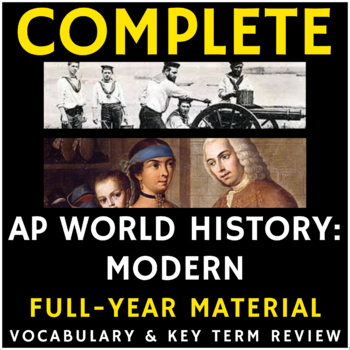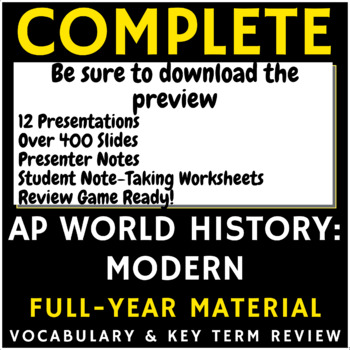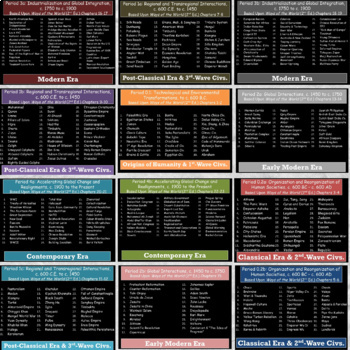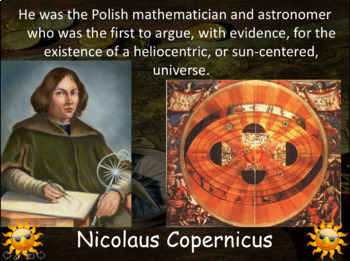BUNDLE! PowerPoint AP World History Modern - Full Year Unit 1-9 Review
- Zip
Products in this Bundle (10)
showing 1-5 of 10 products
Also included in
- Full Year Curriculum Presentations and Review!NOW includes additional copies in Google Slides format of most presentations! Use PowerPoint or Google! Editable presentations throughout!Great Prep for the 2024 Exam!Excellent resource for many different teaching-learning models: student-centered, virtuPrice $164.99Original Price $275.21Save $110.22
Description
Editable presentations!
Full Year Curriculum Review!
Great Prep for the 2024 Exam!
Excellent resource for many different teaching-learning models: student-centered, virtual learning, FLIPPED CLASSROOM models, student review, direct instruction, or even distance learning (if we have to face that again)! If you don't have time to lecture through all the material, share this with students to have them study and review the topic.
Includes presentation transcripts as a teacher key for each PowerPoint!
NOW includes SPICE-T and Vocabulary note-taking worksheets!
My PowerPoints are designed to be viewed in presentation mode. Be sure to DOWNLOAD THE PREVIEW to see this presentation in action!
Bulk Price! This price is an over 10% DISCOUNT compared to purchasing all AP World History Modern Vocabulary Review PowerPoints separately from my store!
Please check out the PREVIEW for a clearer look at what this purchase includes.
AP World History Modern - Complete Set Period 1-4 (Unit 1-9) Vocabulary Review PowerPoint Presentations. This purchase includes 12 PowerPoint presentations.
Includes a total of 401 vocabulary terms with images!
Again, this includes 12 separate PowerPoint Presentations at a bulk discounted price! This is my complete set of AP World History Modern Periodization Vocabulary Review PowerPoint Presentations.
12 PowerPoints with a total of 401 topics from the AP World History Modern College Board Periods 1-4.
Topics are primarily based upon Robert Strayer, Ways of the World, 2nd Ed.
Includes images, vocabulary and definitions, with animations.
Optional BINGO Game Procedure: (1)Students fill in BINGO boards with terms from the list. (2)Teacher proceeds to next slide, which displays only a definition that matches a term from the list. (3)Students raise hand to verbally match the definition to one of the terms from the term page/their BINGO board. (4)If student is correct, teacher proceeds to show the animated term+image(s). If student is incorrect, proceed with new volunteer.(5)Game proceeds until all terms have been used or until teacher/time decides. *Game rules & procedure can easily be adapted to fit your desires.
Use my FREE pdf BINGO 16-square game board!
Or, just use this for a class review activity of your choice.
Check Out all of my AP World History Products HERE!
Check Out all of my FREE Products HERE!
NOTE: This also includes 3 presentations from, what has come to be known as, "Period 0", which is material covered from Prehistory to AD 1200. This information can be used as a resource for front-loading students with historical background to the units of AP World History Modern.
Terms Included in This Purchase:
Period 0.1:
- Paleolithic Era
- Egalitarian States
- Jomon
- Chumash
- Clovis Culture
- Gobekli Tepe
- Neolothic Era
- 1st Agr. Revolution
- Fertile Crescent
- Grains & Cattle
- Bantu
- Hittites
- Hadza
- Pastoralists
- Saka Pastoralists
- The Igbo
- Chiefdom
- Cradle of Civ.
- Sumerian Civ.
- Egyptian Civ.
- Norte Chico Civ.
- Indus Valley Civ.
- Xia, Shang, & Zhou
- Oxus Civ.
- Olmec Civ.
- Epic of Gilgamesh
- Code of Hammurabi
- Mohenjo Daro
- Uruk
- Abraham
Period 0.2:
- Athens
- The Punic Wars
- Emperor Ashoka
- Confucianism
- Octavian Augustus
- Patricians
- Plebeians
- City-States
- Hellenistic Era
- Macedonian
- Siddhartha Gautama
- Alexandria
- Sui, Tang, Song
- Cyrus and Darius
- Analects
- Legalism
- Han
- Aristotle
- Persopolis
- Persian Empire
- Upanishads
- Roman Empire
- Shihuangdi
- Vedas
- Mahayana
- Theravada
- Bureaucracy
- Bhagavad Gita
- Judaism
- Pax Romana
- Daoism
- Socrates
- Peloponnesian War
- Zoroastrianism
- Plato
- Republic
- Chaco
- Brahmins
- Wari & Tiwanaku
- Helots
- Hopewell Culture
- Moche
- Greco-Roman Slavery
- Yellow Turban Rebellion
- Wang Mang
- Kshatriya
- Karma & Rebirth
- Sparta
- Niger Valley Civ.
- Jatis
- Teotihuacan
- Spartacus
- Varnas
- Meroe
- Cahokia
- Three Obediences
- Emperor Wu Di
- Empress Wu
- Chavin
- Vaisya
- Axum
- Bantu
- Aspasia & Pericles
- Dalits
- Piye the Kushite
- Jenne-jeno
- Maya
- Sudras
- Landlords
Period 1: Unit 1 - 2
- Silk Roads
- Dunhuang
- Fotudeng
- Bubonic Plague
- Sea Roads
- Srivijaya
- Borobudur Temple
- Angkor Wat
- Swahili
- Great Zimbabwe
- Sand Roads
- Ghana, Mali, & Songhay
- American Web
- Timbuktu
- Thorfinn Karlsfeni
- Pochteca
- Incan Empire
- Sui Dynasty
- Economic Revolution (China)
- Hangzhou
- Golden Age
- Foot Binding
- Tribute System
- Hangul
- Bushido
- Xiongnu
- Khitan & Jurchen
- Silla Kingdom
- Chu nom
- Shotoku Taishi
- Samurai
- Chinese Buddhism
- Emperor Wendi
- Muhammad
- Quran
- Umma
- Pillars of Islam
- Hijra
- Sharia
- Jizya
- Ulama
- Imams
- Caliph
- Umayyad Caliphate
- Abbasid Caliphate
- Sufism
- Rightly Guided Caliphs
- Shia
- Sunni
- Al-Ghazali
- Sikhism
- Hadiths
- Timbuktu
- Mansa Musa
- Al-Andalus
- Madrassas
- House of Wisdom
- Ibn Sina
- Nubian Christianity
- Jesus Sutras
- Ethiopian Christianity
- Byzantine Empire
- Constantinople
- Justinian
- Caesaropapism
- Eastern Orthodox
- Icons
- Prince Vladimir
- Kievan Rus
- Charlemagne
- Holy Roman Empire
- Roman Catholic
- Crusades
- Pastoralism
- Modun
- Xiongnu
- Turks
- Almoravid Empire
- Chinggis Khan
- Mongol World War
- Yuan Dynasty
- Khubilai Khan
- Hulegu
- Karakorum
- Khutulun
- Kipchak Khannate
- Black Death
- Zheng He
- Igbo
- Iroquois
- Timur
- Fulbe
- Ming Dynasty
- Renaissance
- Ottoman Empire
- Fall of Constantinople
- Safavid Empire
- Songhay Empire
- Timbuktu
- Mughal Empire
- Malacca
- Aztec Empire
- Inca Empire
- Paleolithic Persistence
Period 2: Unit 3 - 4
- Hernan Cortés
- Great Dying
- Doña Marina
- Columbian Exchange
- Peninsulares
- Mestizo
- Plantation Complex
- Mulattoes
- Settler Colonies
- Siberia
- Yasak
- Qing Empire
- Mughal Empire
- Akbar
- Aurangzeb
- Ottoman Empire
- Constantinople
- Devshirme
- Indian Ocean Network
- Trading Post Empire
- Spanish Philippines
- British East India Co.
- Dutch East India Co.
- Tokugawa Shogunate
- Silver Drain
- Potosi
- Soft Gold
- African Diaspora
- Benin Kingdom
- Dahomey Kingdom
- Protestant Reformation
- Counter-Reformation
- Taki Onqoy
- Ursula de Jesus
- Jesuits
- Jesuits in China
- Wahhabi Islam
- Kaozheng
- Mirabai
- Sikhism
- Scientific Revolution
- Copernicus
- Johannes Kepler
- Galileo
- Adam Smith
- Isaac Newton
- John Locke
- Rousseau
- Encyclopedie
- Karl Marx
- Enlightenment
- Voltaire
- Condorcet & “The Idea of Progress”
Period 3: Unit 5 - 6
- North American Rev.
- Declaration of Independence
- French Revolution
- Louis XVI
- National Assembly
- Maximilien Roberspierre
- James Madison
- U.S. Constitution
- Federalist Papers
- Dec. of the Rights of Man
- Napoleon
- Haitian Revolution
- Toussaint Louverture
- Spanish Amer. Revs.
- Simon Bolivar
- Jose De San Martin
- Hidalgo-Morales Rebellion
- Abolitionist Movement
- Quakers & Protestants
- Nationalism
- Vindication of the Rights of Woman
- Elizabeth Cady Stanton
- Maternal Feminism
- Kartini
- Britain and Brazil
- Steam Engine
- Britain
- Indian Textiles
- Middle Class Values
- Lower Middle Class
- Ellen Johnston
- Karl Marx
- Labour Party
- Socialism in the U.S.
- Progressives
- Russian Rev. of 1905
- Caudillos
- Latin Amer. Export Boom
- Mexican Revolution
- Dependent Development
- European Racism
- Scramble for Africa
- Indian Rebellion
- Congo Free State
- Leopold II
- Cultivation System
- Cash-Crop Agr.
- Western-Educ. Elite
- Africanization of Christianity
- Swami Vivekenanda
- Edward Blyden
- Imperialism
- Colonies
- Social Darwinism
- Disunity & Technology
- Boer War
- Liberia & Ethiopia
- Australia & New Zealand
- Taiping Uprising
- Opium Wars
- Emperor Qianlong
- Unequal Treaties
- Self-Strengthening Movement
- Boxer Uprising
- Commissioner Lin
- Chinese Revolution of 1911
- “Sick Man of Europe”
- Tanzimat
- Young Ottomans
- Sultan Abd al-Hamid ll
- Young Turks
- Informal Empires
- Tokugawa Japan
- Meiji Restoration
- Russo-Japanese War
- Matthew Perry
Period 4: Unit 7 - 9
- WWI
- Treaty of Versailles
- Woodrow Wilson
- The Fourteen Points
- Great Depression
- New Deal
- Fascism
- Benito Mussolini
- Nazism
- Adolf Hitler
- Revolutionary Right
- WWII
- Total War
- Holocaust
- Euro. Econ. Community
- Marshall Plan
- NATO
- Bolshevik Revolution
- Vladimir Lenin
- Guomindang
- Mao Zedong
- Chinese Revolution
- Joseph Stalin
- Building Socialism
- Zhenotdel
- Collectivization
- Cultural Revolution
- Great Purge
- Fidel Castro
- Cuban Missile Crisis
- Nikita Khrushchev
- Deng Xiaoping
- Perestroika
- Glasnost
- Mikhail Gorbachev
- Boris Yeltsin
- Decolonization
- Indian Nat. Congress
- Mahatma Gandhi
- Satyagraha
- Muslim League
- Muhammad Ali Jinnah
- Abdul Ghaffar Khan
- African Nat. Congress
- Nelson Mandela
- Black Consciousness
- Soweto
- Military Government
- Globalization of Dem.
- Import-Substitution
- Export-Led Ind.
- Mustafa Ataturk
- Ayatollah Khomeini
- Neoliberalism
- Reglobalization
- Transnational Corporations
- North/South Gap
- Anti-Globalization
- Prague Spring
- Che Guevara
- 2nd-Wave Feminism
- Fundamentalism
- Hindutvu
- Islamic Renewal
- Osama bin Laden
- Al-Qaeda
- Global Warming
- Environmentalism
- Rachel Carson
*PLEASE REMEMBER TO POST REVIEWS of all the products you download on TpT. It benefits the hard work of the teachers on here*






